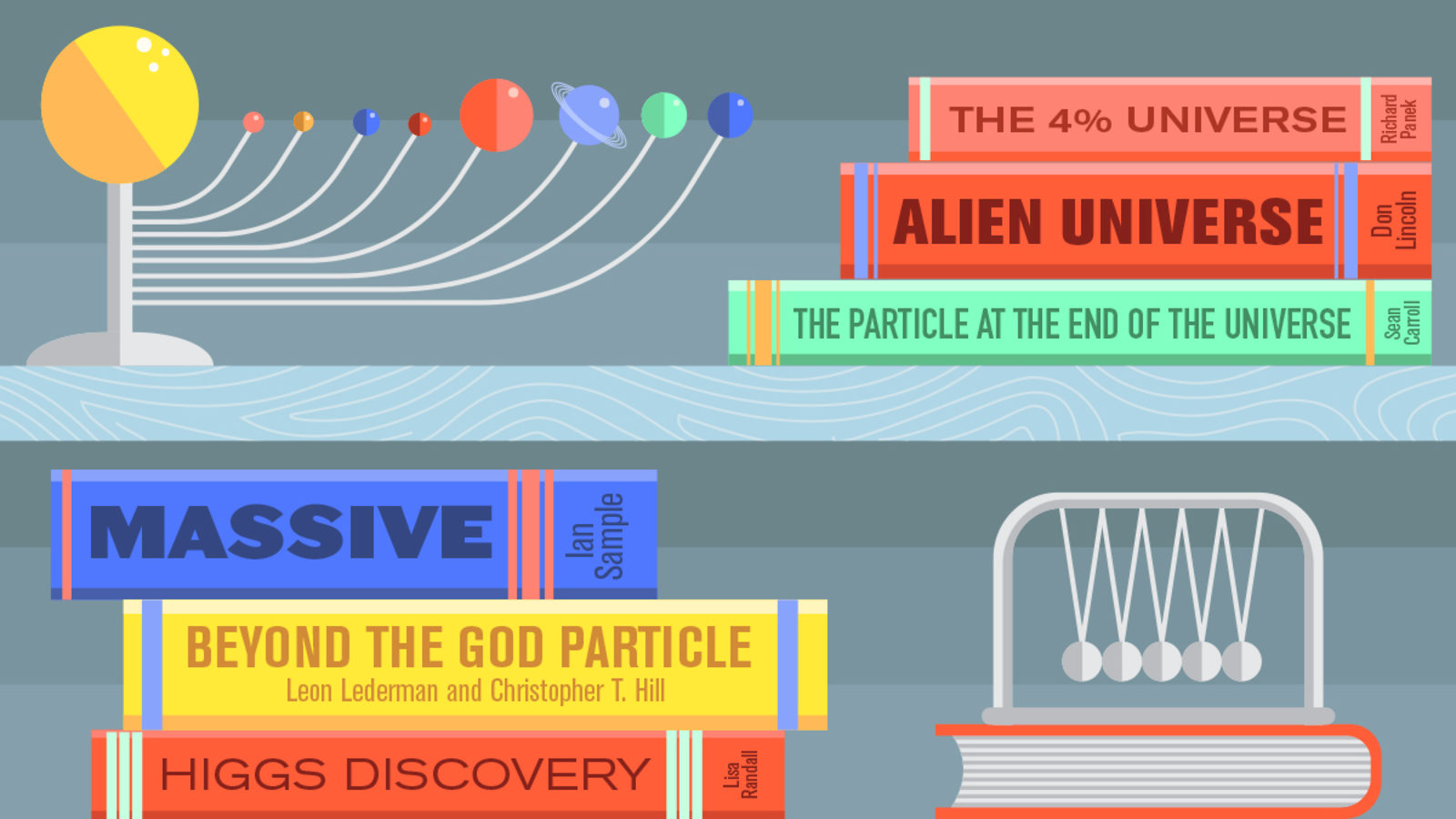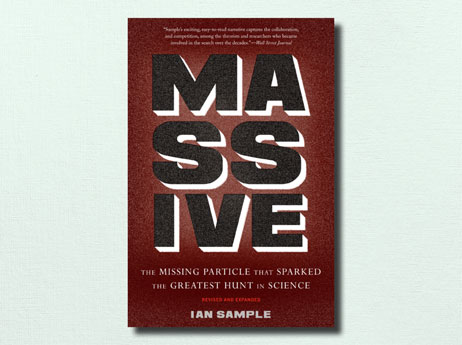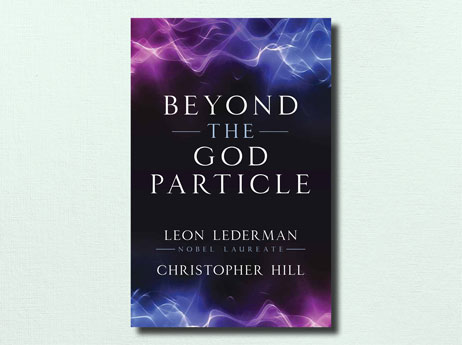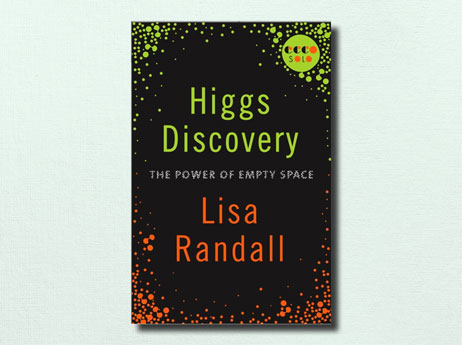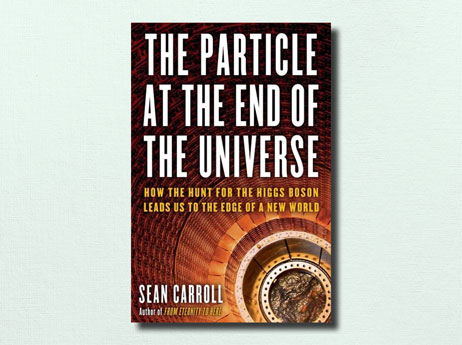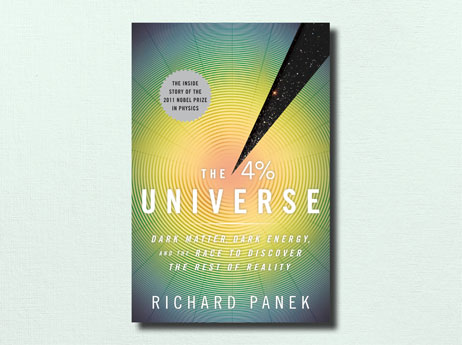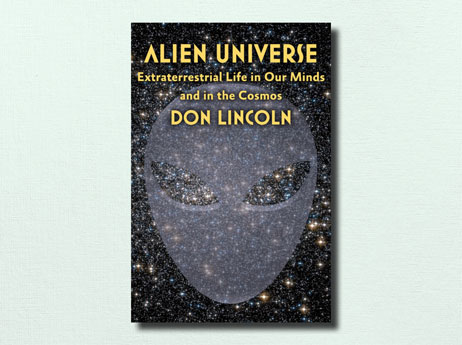It’s been two decades and thousands of popular science books since particle physicist and former Fermilab director Leon Lederman first served up science on wry in The God Particle, his contemplation on the subatomic particles and forces that make up the fundamental building blocks of nature. Lederman’s devilish moniker for the elusive Higgs boson might have rubbed some scientists the wrong way, but the catchy name for the then-theoretical boson has proved a useful hook for science writers, editors and readers.
In 2008, the Large Hadron Collider turned on its particle beams for the first time. Four years later, scientists working on the LHC inaugurated a new era of particle physics with the announcement of the discovery of the Higgs particle. With the 2013 Nobel Prize in Physics going to Peter Higgs and François Englert for originally theorizing the particle, the circle seems complete—except for the numerous questions that remain about the Higgs particle and its potential connections to dark matter, dark energy and other parts of the microcosm.
With the LHC shut down until 2015 for upgrades, now is the ideal time to catch up on reading the new and noteworthy literature of the LHC/Higgs era (2008 to the present).
The particle-scientist duality
Now 84, Peter Higgs has been largely successful at holding notoriety at arm’s length over the decades since he set down his theory about the origin of mass in 1964. It might seem natural to begin LHC/Higgs era reading with a Higgs biography but, surprisingly, none exist (not yet, at least—the Nobel might finally make that inevitable).
The closest to a biography out there is The Guardian science journalist Ian Sample’s MASSIVE: The Missing Particle That Sparked the Greatest Hunt in Science. Sample, who gained an unusual level of access to Higgs in writing the book, notes that Higgs hasn’t exactly been hiding, and that he’s more elusive than reclusive. He offers some telling snapshots of Higgs at work at the University of Edingburgh in Scotland and building the case for his theory of how particles can acquire mass.
Just two years after publishing his seminal paper, Higgs was embarking on a sabbatical year in the United States at the University of North Carolina when he received an invitation to talk about his paper at Princeton. Then he was immediately invited to speak at Harvard. Both talks were well received, and Higgs gained confidence that he and his theory were on sound footing.
Sample (a PhD biomedical scientist) makes it clear that other scientists were thinking about what came to be known as the Higgs field, and some had actually beaten Peter Higgs into print, if barely. Higgs was also fully aware of all the others working on the idea. He knew there was always friction over receiving credit among the scientific community, and seemed uncomfortable with having his name on the marquee. Sample writes that at one conference, Higgs suggested that the mechanism “should be renamed the ‘ABEGHHK’tH mechanism’ after all the people [Anderson, Brout, Englert, Guralnik, Hagen, Higgs, Kibble and ‘tHooft] who discovered it or rediscovered it.”
Sample’s compelling story extends well beyond Higgs himself, with a thorough history of particle physics up to the threshold of the CERN discovery. Published in 2010, MASSIVE leaves us with the image of Peter Higgs waiting patiently if wearily for the particle’s appearance. “It’ll be a relief,” Higgs says. “It’s been a long journey.”
Science as an economic driver
Leon Lederman has been around for all of the journey, and then some. The Nobel Laureate and Fermilab director emeritus has teamed with Fermilab theorist Christopher T. Hill to co-author Beyond the God Particle. Brand-new in October 2013, it sets historical and scientific context for the Higgs, in the breezy plain-speak style that Lederman and Hill patented in their previous collaborations (Quantum Physics for Poets, Symmetry and the Beautiful Universe).
A critical segment of the Lederman-Hill book, especially for non-scientists, makes a compelling case for the economics of “big science” projects like those common in particle physics, and the economic concept of “exogenous input.”
In a nutshell, exogenous input is the outside force that drives economic growth. Identifying that key input was a historically tough nut for economists to crack. Then along came Robert Solow of MIT, who developed a raft of equations to analyze economic growth, captured the Nobel Prize in 1987, and came up with a surprising answer.
“It turns out that what drives an economy is science, science, science,” says Hill, who took a class from Solow at MIT. “If you want to create jobs, spend on science. … It was right there for everyone to see with Tim Berners-Lee and the World Wide Web. Much of our postwar economic boom from 1945 to the present grew from quantum mechanics. We take it for granted when we take out our cell phone and charge the battery.”
Hill sees public awareness as critical because there are many more questions to answer about the Higgs.
“Everything depends on what the LHC begins telling us in 2015,” he says. “Is the Higgs a loner, or is it part of a family? The answer will completely script the kind of particle accelerator we will want in the future. Without cutting-edge accelerator science, we will slowly lose our lead in this subject. What are we going to do? Are we going to be leaders in the field?”
Hill says the book is “dedicated to the US taxpayers who support research with their tax dollars. We hope the reader will come away saying this is an essential pursuit and there’s a lot more to do.”
Two timely Higgs books
Harvard theorist Lisa Randall published an e-book for Kindle readers within weeks of the July unveiling. On vacation in Europe when the Higgs announcement was made, she was eager to put her thoughts forward on the questions she knew would be coming at a series of upcoming talks.
“When I am excited, I can write very quickly,” Randall says. “This was a short e-book with a definite subject. So it was much more efficient and easy to write than my two full-length books, which cover a broad range of material.”
She began writing. She met with a London-based partner of her book agent, who advised against the e-project. But Randall showed her the work in progress and got her blessing to go ahead.
Still, Randall felt the pull of getting back to research after having focused time and effort on writing and promoting her previous book, Knocking on Heaven’s Door.
“So I made a deal with myself I would do the book only if I could finish it in a week,” she says. “I was fairly confident I could do it and do a good job. I was less confident my editor and publisher would agree to this time scale. But, to their credit, they did and even came up with a cover I liked and could tweak a bit, and it all happened within about 10 days!”
Higgs Discovery: The Power of Empty Space (now also out in paperback) includes excerpts from Randall’s previous books, Warped Passages: Unraveling the Mysteries of the Universe's Hidden Dimensions; and Knocking on Heaven’s Door: How Physics and Scientific Thinking Illuminate the Universe and the Modern World, along with her treatise on the Higgs and what she sees as the next looming questions.
“One question raised [by the Higgs] is why it has the mass that it has,” she says. “And, of course, we want to know if all the interactions agree with what is predicted in the simplest Higgs model. We also want to know what completes the model and keeps the Higgs boson light. [The Higgs mass] also reinforces the question of whether or not the LHC will reach high enough energy to answer this last question, known as the hierarchy problem.”
Theorist Sean Carroll of Caltech already had a Higgs book in the works and was on the scene at CERN with a TV documentary crew when he was swept up in the July 4, 2012, announcement. He found himself “masquerading as a journalist,” herded into a press gallery with other media types. He turned the experience into a key ingredient of The Particle at the End of the Universe: How the Hunt for the Higgs Boson Leads Us to the Edge of a New World, which came out in hardcover in November 2012 and paperback in August 2013.
“Based on the CERN seminars from December 2011, many people recognized that an imminent Higgs discovery seemed likely,” Carroll says. “That's what gave the impetus for writing the book in the first place. I worked quickly and actually had most of it done by July 2012. In fact the announcement was ultimately a bit earlier than we expected, but I was able to work it into the book.”
Carroll, a cosmologist, is especially focused on the Higgs in connection with dark matter and dark energy, and with inflation, the era of super-expansion in the early universe.
“The Higgs,” he says, “is crucial for experiments here on Earth that are trying to find the dark matter. For dark energy, the Higgs… is definitely a contributor, although presumably not the only one. As far as inflation goes, it’s not likely—although it is possible—that there's a direct connection to the Higgs.”
A mystery as big as the universe
Although the search for and discovery of the Higgs boson dominated public particle-physics consciousness in the LHC/Higgs era, it’s not the only major accomplishment to come in the past several years. We've encountered a mystery as big as the cosmos.
Dark energy, Saul Perlmutter has said, is “the placeholder for how much we don’t know about the universe.”
Perlmutter, an astrophysicist at Lawrence Berkeley National Laboratory, won half of the 2011 Nobel Prize in Physics; the remaining half was shared between Brian Schmidt of the Australian National University and Adam Riess of The Johns Hopkins University and the Space Telescope Science Institute. Together, they and their teams had spent 10 years researching Type IA supernovae and reached a stunning conclusion, announced in 1997 and 1998: The expansion of the universe was accelerating.
Instead of a universe of visible, tangible matter, the cosmic formula is now estimated as 73 percent dark energy, 23 percent dark matter and 4 percent ordinary matter: stars and planets, tables and chairs.
Science writer Richard Panek, affiliated with Barnard College in New York and Goddard College in Vermont, had written about the supernovae results in Esquire Magazine in 1998, and about dark energy in The New York Times Magazine in 2007. The Times Magazine piece was literally the springboard to The 4 Percent Universe: Dark Matter, Dark Energy, and the Race to Discover the Rest of Reality, published in 2011.
“While researching the Times Magazine article,” Panek recalls, “I made the acquaintance of many of the principals in both dark matter and dark energy, and I let them know that I hoped to turn the article into a book. In fact, the book deal was finalized the same week the article came out, so my contact with them was pretty much an unbroken continuation. But then, I've always found scientists to be eager to talk about their work and to be generous with their time.”
The accelerating universe and the Higgs particle are linked as history-making discoveries, but they are different in character: The Higgs was largely regarded as inevitable, but the accelerating universe was a stunner.
In his comments at the Nobel banquet, Perlmutter said: “Perhaps the only thing better for a scientist than finding the crucial piece of a puzzle that completes a picture is finding a piece that doesn't fit at all, and tells us that there is a whole new part of the puzzle that we haven't even imagined yet and the scene in the puzzle is bigger, richer than we ever thought.”
Is anybody out there?
The ultimate stunner would be finding “somebody else” out in the universe among the newly discovered hordes of exoplanets. Fermilab’s Don Lincoln conducts a fun tour in Alien Universe: Extraterrestrial Life in Our Minds and in the Cosmos (October 2013). Lincoln traces our alien imaginings from the earliest awareness of other planets through Hollywood hits and misses.
“The idea of the book is to cover the evolution of mankind’s vision of aliens over the decades,” Lincoln says. “There have been many different visions offered over the years, and the aliens in movies have often reflected the worries of the time, from communist infiltration to outright war.”
There’s also some real science applied to possible alternate life forms.
“I talk about chemistry and how what we know about atomic bonds tells us some real limitations as to what is likely to be an alien,” Lincoln says. “Among even fairly sophisticated lay people, the idea of silicon-based life is supposed to be reasonable, but we find that it really isn’t. The book ends with the attempt to listen in on SETI radio conversations. The fact that we haven’t heard from ET sets some bounds on the cosmopolitan nature of our cosmic neighborhood.”
Lincoln also gives voice to one of the goals of science writing that is widely shared if not always spoken.
“I’m sure that somewhere out there,” he says, “there is a child or young adult… who needs only an introduction to science to have a new vista opened to them, to show them a new life. I hope that someday one of my books has that effect.”
New and noteworthy popular science reading in the LHC/HIGGS era (2008-present)
The Day We Found the Universe
Marcia Bartusiak
New Year’s Day, 1925: Edwin Hubble announces his finding that the universe is immeasurably larger than we ever imagined. Soon thereafter he showed that the universe is expanding. The complete cast of characters in a stunning mini-age of discovery.
A Palette of Particles
Jeremy Bernstein
Physicist and former New Yorker staff writer on a subtly shaded tour of particle physics from Rutherford to the Higgs.
Superconductivity: A Very Short Introduction
Stephen Blundell
Fermilab’s Tevatron made superconductivity a mature technology, and now the LHC has used a 27-km ring of superconducting magnets to inaugurate the Higgs era. Blundell is an Oxford physicist.
The Particle at the End of the Universe
Sean Carroll
Theorist Sean Carroll presents an up-to-date account of the state of particle physics and, in particular, the discovery of the Higgs boson.
The Infinity Puzzle: Quantum Field Theory and the Hunt for an Orderly Universe
Frank Close
Oxford theorist takes on quantum field theory and how the Higgs might help make sense of it.
Nothing: A Very Short Introduction
Frank Close
A history of the vacuum, from discovering the electron, to virtual particles and antiparticles, to the Higgs field. Can nothing actually exist? Wide-ranging series by Oxford University Press.
Neutrino
Frank Close
What are neutrinos trying to tell us about the universe? We still don’t know, 80 years after Pauli’s “desperate remedy.” Another entry in the Oxford series.
An Appetite for Wonder: The Making of a Scientist
Richard Dawkins
Not a physicist, but a mind well worth knowing. Memoir.
The New York Times Book of Physics and Astronomy: More Than 100 Years of Covering the Expanding Universe
Cornelia Dean (editor)
All the news that’s fit to print by stellar and award-winning journalists. Topics ranging from Bohr and Einstein to the discovery of the Higgs.
Hubble’s Universe: Greatest Discoveries and Latest Images
Terence Dickinson
Contains many recent images and others not previously available for wide distribution.
The Large Hadron Collider: A Marvel of Technology
Lyn Evans (editor)
Evans is lead scientist of the LHC program, with 40 years of service at CERN. For scientists, students and the tech-savvy.
The Feynman Lectures on Physics, boxed set: The New Millennium Edition
Richard Feynman, Robert Leighton, Matthew Sands
An absolute prize. Must-have for a physicist or physics student. (Bongos not included)
Einstein’s Telescope: The Hunt for Dark Matter and Dark Energy in the Universe
Evalyn Gates
Astrophysicist Gates, assistant director of the Kavli Institute for Cosmological Physics, explores the use of gravitational lensing in the search for dark matter and dark energy.
The Universe in the Rearview Mirror: How Hidden Symmetries Shape Reality
David Goldberg
Award-winning physics professor (Drexel University) and blogger gives long-overdue praise to mathematician and Nazi holocaust escapee Emmy Noether in exploring the concept and importance of symmetry in 20th century physics.
A User’s Guide to the Universe: Surviving the Perils of Black Holes, Time Paradoxes, and Quantum Uncertainty
David Goldberg, Jeff Blomquist
An irreverent take on just about anything you can think of in modern physics, complete with cartoons. Goldberg is a gift.
At the Leading Edge: The ATLAS and CMS LHC Experiments
Dan Green (editor)
Fermilab’s Green was the key manager of the US CMS construction effort. For scientists, students and the tech-savvy.
The Hidden Reality: Parallel Universes and the Deep Laws of the Cosmos
Brian Greene
One universe or many? One big bang or an infinite number? This wouldn’t be a complete list without Greene.
Space, Time and the Universe with Brian Greene
Brian Greene
Greene’s TV series The Elegant Universe and Fabric of the Cosmos together on DVD.
Erwin Schrödinger and the Quantum Revolution
John Gribbin
More rumpled than Einstein, a devotee of eastern religion and philosophy, and infamous for his alternative lifestyle: Schrödinger won the 1933 Nobel Prize in Physics and will be forever remembered for the “Schrödinger’s cat” quantum enigma.
An Astronaut’s Guide to Life on Earth: What Going to Space Taught Me About Ingenuity, Determination, and Being Prepared for Anything
Col. Chris Hadfield
An astronaut with almost 4000 hours in space tells what he learned: “Prepare for the worst—and enjoy every moment of it.” Like breaking into a space station with a Swiss army knife.
Edge of the Universe: A Voyage to the Cosmic Horizon and Beyond
Paul Halpern
Could the universe be a hologram with everything that happens within it written on its edge?
Collider: The Search for the World’s Smallest Particles
Paul Halpern
Covers all the basics, plus a sound scientific de-bunking of the “earth-swallowed-by-a-black-hole-in-the-accelerator” myth.
George and the Big Bang
Stephen Hawking, Lucy Hawking and Garry Parsons
For grades 3 through 7—including essays by Stephen Hawking, Michael Turner, Paul Davies and Kip Thorne; how’s that for a book aimed at an 8-year-old? Check out all the George books.
The Grand Design
Stephen Hawking and Leonard Mlodinow
Where does it all come from and why is it the way it is? Pitched to lay audiences, but be prepared for a challenge as always.
My Brief History
Stephen Hawking
Diagnosed with amyotrophic lateral sclerosis at 21, Hawking is now in his 70s—incredible for anyone with ALS. His first memoir.
Galileo
John L. Heilbron
Biography of the starry messenger who started it all.
Fermilab: Physics, the Frontier, and Megascience
Lillian Hoddeson, Adrienne Kolb and Catherine Westfall
A trio of science historians (Kolb is Fermilab’s official historian) focus on the first two decades of big science on the Illinois prairie, under directors Robert Wilson and Leon Lederman.
Nature’s Blueprint: Supersymmetry and the Search for a Unified Theory of Matter and Force
Dan Hooper
Fermilab theoretical astrophysicist Hooper chronicles the ongoing search for the “spartner sparticles” of supersymmetry, now on hiatus at the LHC until 2015.
Einstein: His Life and Universe
Walter Isaacson
Noted biographer (Benjamin Franklin, Steve Jobs) with first full biography of Einstein since all of his papers have become available.
How the Hippies Saved Physics: Science, Counterculture, and the Quantum Revival
David Kaiser
MIT physicist and historian Kaiser argues that the field of quantum information science owes its existence to a bunch of Berkeley stoners in the 1970s. Right or wrong, who can resist the title?
Physics of the Impossible: A Scientific Exploration into the World of Phasers, Force Fields, Teleportation, and Time Travel
Michio Kaku
Kaku, string theorist and professor at City University of New York, takes a look at some maybe-it’s-not-so-impossible-after-all phenomena. No strings attached.
Quantum Man: Richard Feynman’s Life in Science
Lawrence M. Krauss
Entertaining bio of a brilliant scientist and fascinating personality. One of “Great Discoveries” series published by W.W. Norton. All are worth reading.
A Universe from Nothing: Why is There Something Rather Than Nothing?
Lawrence M. Krauss; Afterword by Richard Dawkins
Not only did something come from nothing; Krauss attempts to show that something will always arise from nothing.
Beyond the God Particle
Leon M. Lederman and Christopher T. Hill
Lederman, the Nobel Laureate and Fermilab Director emeritus, teams up with Fermilab theorist Hill for an inimitable look at where the field has traveled up to the discovery of the “God Particle” at CERN.
Quantum Physics for Poets
Leon M. Lederman and Christopher T. Hill
You don’t have to be a poet to appreciate the “Eureka” moments of Planck, Bohr, Einstein and others grappling with the conundrums of quantum physics.
Alien Universe: Extraterrestrial Life in Our Minds and in the Cosmos
Don Lincoln
Lincoln shows that the aliens in our minds are at least as interesting as the aliens that might or might not be somewhere in the cosmos.
The Quantum Frontier: The Large Hadron Collider
Don Lincoln
Experimenter Lincoln set the scene and science context for the big machine as it began operations.
Brilliant Blunders: From Darwin to Einstein—Colossal Mistakes by Great Scientists That Changed Our Understanding of Life and the Universe
Mario Livio
Congenial astrophysicist Livio urges us to accept that the path of science is not linear but follows a zigzag to its objective.
The Cosmic Tourist: Visit the 100 Most Awe-Inspiring Destinations in the Universe
Brian May, Patrick Moore, Chris Lintott
Images from a variety of telescopes, with commentary by Moore and Lintott, from BBC’s The Sky at Night; and May, guitarist for the legendary rock band Queen and a PhD astrophysicist.
Robert Oppenheimer: His Life and Mind (A Life Inside the Center)
Ray Monk
The complex leader of the atomic bomb project, Oppenheimer ran afoul of McCarthyism in the 1950s. Monk has also written biographies of Ludwig Wittgenstein and Bertrand Russell.
George Gamow: The Whimsical Mind Behind the Big Bang (Kindle Edition)
Beverly Orndorff
Biography of George Gamow. Between jokes, pranks and cocktails, Gamow wrote the indispensable “Mr. Tompkins” books and predicted the existence of the cosmic microwave background—the evidence of the Big Bang.
The 4 Percent Universe: Dark Matter, Dark Energy and the Race to Discover the Rest of the Universe
Richard Panek
The story of the supernovae research of Perlmutter, Schmidt and Riess, with the stunning result that the expansion of the universe is accelerating, and the awarding of the 2011 Nobel Prize in Physics.
Good Vibrations: The Physics of Music
Barry R. Parker
Take a break while you learn why a harpsichord sounds different from a piano and how acoustics can tell you something about quantum physics.
Finding the Big Bang
P. James E. Peebles, Lyman A. Page Jr., R. Bruce Partridge (editors)
The story of the discovery and exploration of the Cosmic Microwave Background Radiation in the 1960s is recalled for the first time in this collection of 44 essays by eminent scientists who pioneered the work. For the scientist. Not cheap.
Higgs Discovery: The Power of Empty Space
Lisa Randall
An overview of the Higgs discovery what Randall sees as the next looming questions in particle physics. Also includes excerpts from Randall’s previous books.
A Force of Nature: The Frontier Genius of Ernest Rutherford
Richard Reeves
Rutherford was the first to “see” the nucleus, first to split the atom. An engaging biography, part of the “Great Discoveries” series.
MASSIVE: The Missing Particle That Sparked the Greatest Hunt in Science
Ian Sample
Sample is the science correspondent for The Guardian (UK) and a PhD scientist himself (biomedicine). His unusual close access to Peter Higgs is one of many strengths in a well-told tale of particle physics in tight focus.
The Battery: How Portable Power Sparked a Technological Revolution
Henry Schlesinger
It’s been around since 1800: from Volta’s pile of metal discs to nanotechnology. Where would you and your cell phone be without it?
The Trouble With Physics: The Rise of String Theory, The Fall of a Science, and What Comes Next
Lee Smolin
Founder of Canada’s Perimeter Institute warns fellow theorists they’re straying into realms that can’t be tested experimentally.
Time Reborn: From the Crisis in Physics to the Future of the Universe
Lee Smolin
Smolin argues for a new definition of time to make theories of the universe work. There are other critics of modern physics out there, but they lack Smolin’s gravity.
The Universe Within: From Quantum to Cosmos
Neil Turok
Director of Perimeter Institute explores the transition from digital to quantum technology and the need for social paradigm shift.
The Art and Politics of Science
Harold Varmus
Eminent cancer researcher, Nobel Laureate, director of the National Institutes of Health president of the Memorial Sloan-Kettering Cancer Center; scientific adviser to President Obama: No one has more credibility than Varmus at the critical intersection of science and society.
Lake Views: This World and the Universe
Steven Weinberg
Nobel Laureate and pre-eminent theorist Weinberg in a wide-ranging collection of essays, from his own field of cosmology to world issues. His impact as a writer extends back to works like The First Three Minutes: A Modern View Of The Origin Of The Universe, in 1993.
The Lightness of Being: Mass, Ether, and the Unification of Forces
Frank Wilczek
Nobel Laureate Wilczek surveys current thinking on the interaction of matter and energy, with thoughts of grand unification in his sights. For serious readers.
Do you see a book we missed? Let us know! You can reach us at info@symmetrymagazine.org.



